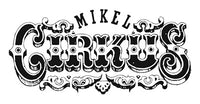Winning Friends
Soliciting business is hard enough if you're in any type of sales position, be it retail or corporate, not-for-profit or just plain selling anything for something - foreseeably a profit - however, an artist is selling something slightly less tangible. An artist makes that decision early on in their development, when they come to that fork in the road, the decision to be a Commercial Artist or a Fine Artist. Commercial Artists make money when they sell their art as a service, while Fine artists make their money when they die. At least that's what your high school art teachers, and parents, lead you to believe. Yishai had chosen a career path as a Fine Artist, one of the most difficult creative disciplines imaginable, and is truly making a living, a career, by making his own art. Today, Yishai is a very well-respected Mexican artist who continues to show and sell his work around the world. I'd been down the road of Commercial Art since entering and winning my first Halloween coloring competition when I was about five years old. A twenty-five-dollar gift certificate to the local sponsoring art store in town, in 1968, went very far, but not as far as my new ten-speed bicycle took me in 1975, which I won with my original art entry for the Kellogg's Stick-Up For Breakfast Contest. It was early validation that my artistic skills just might take me places, and if I could make some money while doing so, even better.
Cold-calling, as an artist-turned-business-owner, is the equivalent of having a critical review of your book, by strangers who may or may not know anything about a good idea or design, in hopes of convincing that person or persons to hire you. Essentially whoring my creativity at a mutually agreed upon price, like a glorified freelancer, Inhouse Productions was ‘me selling me’ with my book of both kinds of Art Direction, which was finally that unique advantage Allen had so geniously orchestrated. Portfolio in hand, my new-found communication skills won me business in formalwear, pharmaceuticals, real estate, and even motorsports. Chris and I scored two tickets to Old Bridge Twp. Raceway Park, in Englishtown, NJ, to go see some local drag racing on a Saturday afternoon. Canon AE-1 at the ready, we picked up a copy of the day's Raceway News and saw that today was "Polaroid OneFilm" Day at the track. The new OneFilm was Polaroid's late entry into the 35mm film market and the souvenir stands had plenty for sale, as there was an exclusive photography contest at Raceway Park happening on this day only. All you had to do was take a picture that best captured the day, using the One Film of course, submit it with a tagline to Raceway Park, and you could win two tickets to the NHRA drag racing finals in Pomona, California, on Pan Am Airlines.
It was the Summer of '89, and Chris and I had just got engaged, so two tickets back to California sounded like a nice prize to go after. I ripped the Kodak out of my camera, and dropped in a roll of the Polaroid, and set out to find THE shot. Knowing my competition, anyone else in the audience with a 35mm camera, it was obvious every one of them would be shooting the cars, so to separate my entry from theirs, I took a picture of them. My winning entry was a picture of the section of the stands just above the Polaroid sponsored billboard, with everyone either taking a picture, using binoculars, or putting their fingers in their ears to muffle the roar of the dragsters. My headline for the image was, "See No Evil. Hear No Evil. - Polaroid OneFilm."
When Raceway Park's Promotions Manager, Ken Landerman, called to tell me that I'd won, he asked me to do him a favor and to please write a "Thank You Note" to the Polaroid Corporation's Brand Manager. Ken was so impressed with the letter I wrote, he asked if I'd be interested in writing the copy for Raceway Park's marketing materials. When I mentioned I happened to have my own, Jersey-based, design studio, he offered me the opportunity to produce their event schedule for the upcoming season, and so on for the next six years, Inhouse was Raceway Park's in-house art department.
It's no secret, and no lie, and for some crazy reason seems to be an adage attributed to Marc Anthony - J-Lo's, not Cleopatra's - 'When you do what you love, and love what you do, you'll never work a day in your life," is akin to following your bliss. Doing what you were meant to be doing. Even in the most demanding circumstances, working on anything for Raceway Park was, in all seriousness, never a drag, and, although OneFilm, Pan Am, and Raceway Park are all gone today, Ken and I have remained friends for over thirty years.



Always an inspiring and delightful read!
I am getting to really understand you and your work/passion through these stories. It is an eye opening adventure for me.
Leave a comment